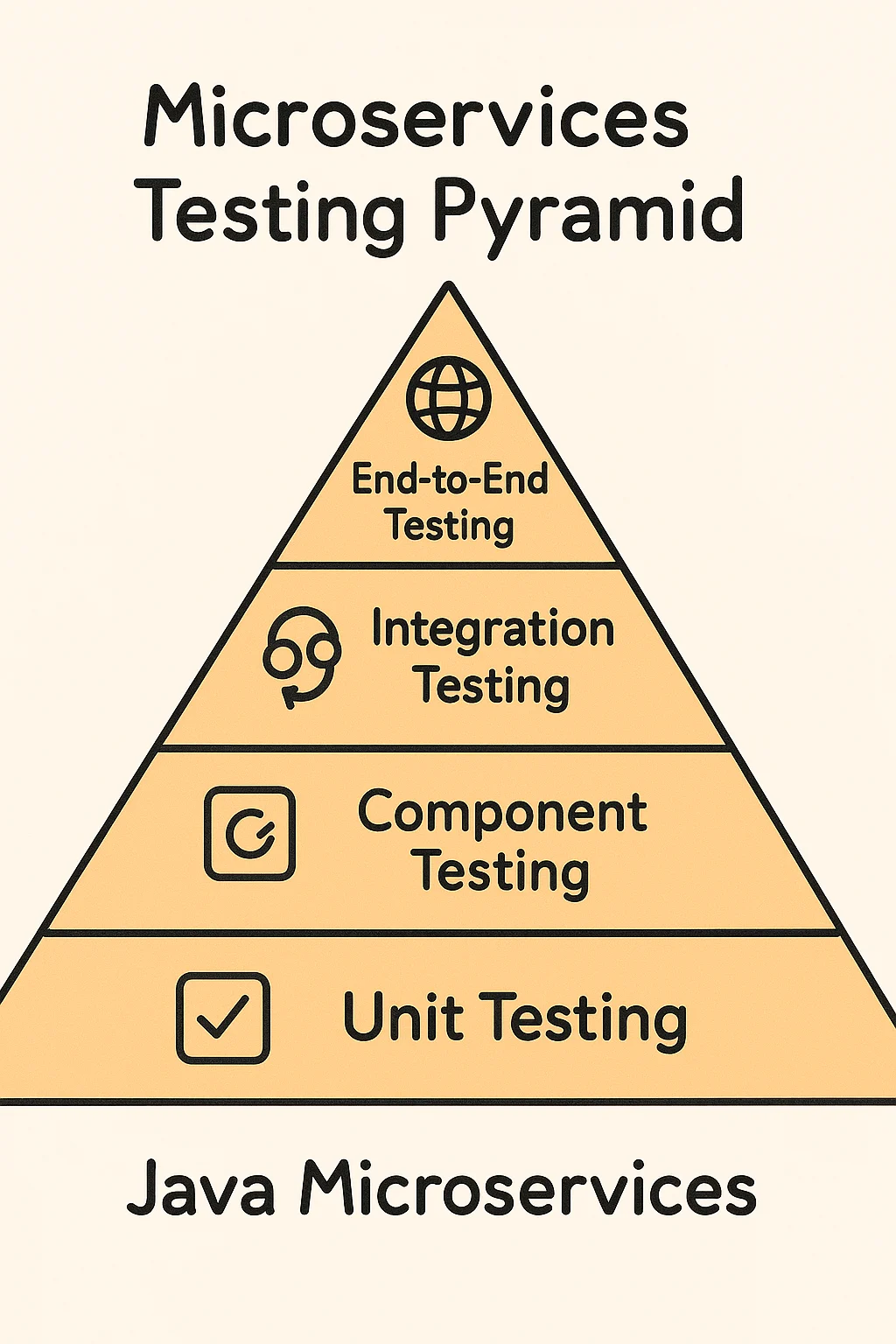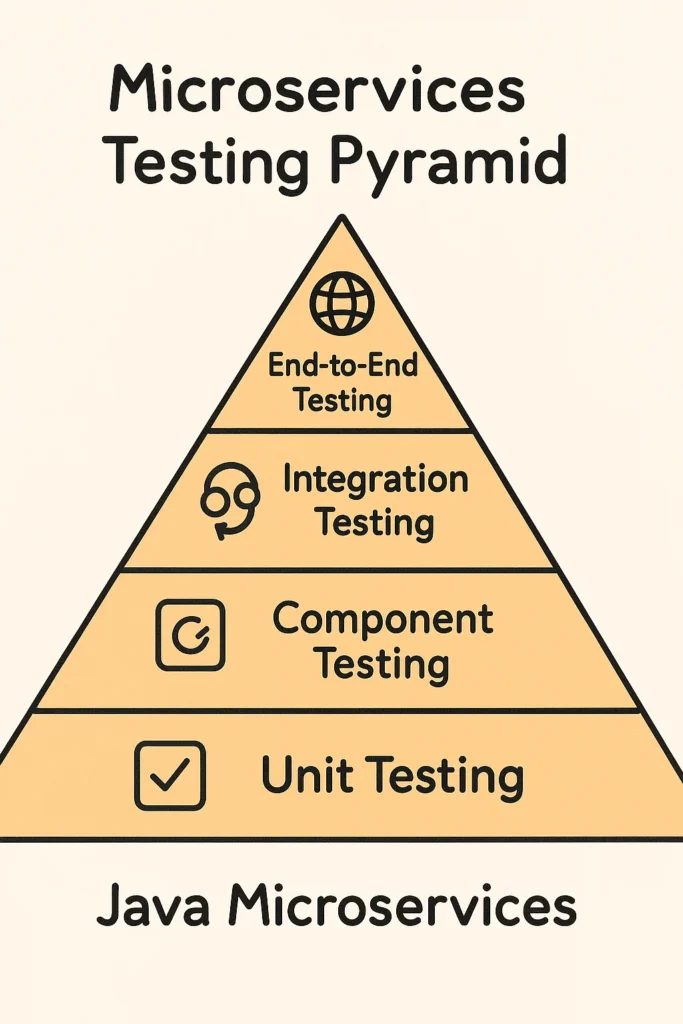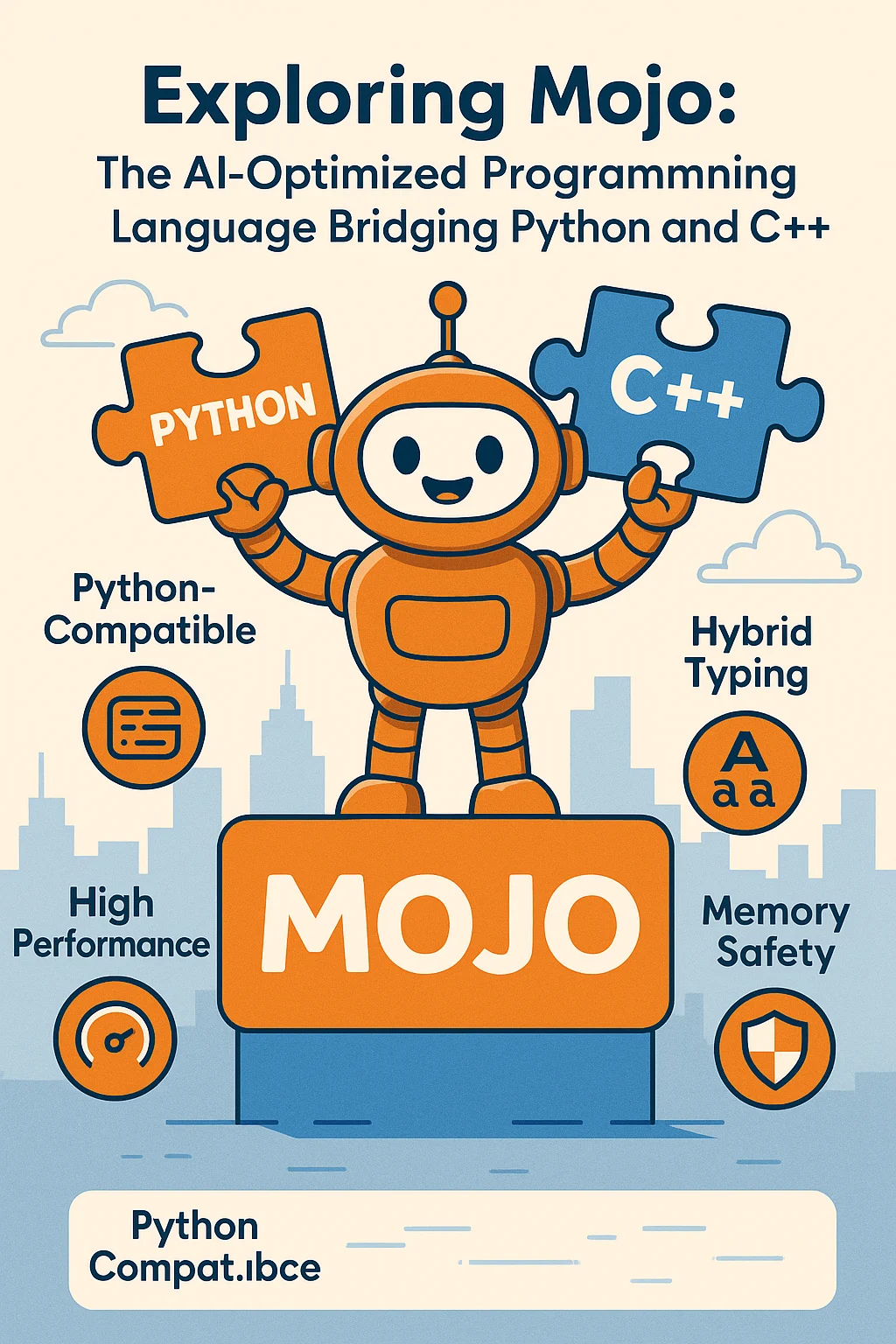Advanced Testing Strategies for Microservices (Java Edition)


Introduction: Why Advanced Testing Matters in Microservices
Microservices architecture enables scalable, modular applications — but it also brings a distributed complexity that traditional testing can’t handle.
When building Java-based microservices (using Spring Boot, JUnit 5, Testcontainers, etc.), advanced testing ensures you catch issues early, automatically, and across service boundaries.
This guide will help you:
- Master testing at multiple layers (unit, integration, e2e).
- Validate inter-service contracts.
- Use real containers for reliable test environments.
- Test resilience with chaos tools.
- Automate everything in your CI/CD pipeline.
Challenges of Testing Microservices
Here’s why testing microservices is harder than testing monoliths:
- Distributed failures (network, service downtime).
- Independent databases per service.
- Multiple API contracts to maintain.
- Test environments often differ from production.
Solution: Build a layered testing strategy, use real containers, monitor behavior, and simulate chaos.
1. Multi-Layered Testing Strategy (Java Edition)
Testing microservices effectively requires several layers:
Unit Testing (Isolate Business Logic)
public class UserService {
public String getGreeting(String name) {
if (name == null || name.isEmpty()) throw new IllegalArgumentException("Name is required");
return "Hello, " + name + "!";
}
}import org.junit.jupiter.api.Test;
import static org.junit.jupiter.api.Assertions.*;
public class UserServiceTest {
private final UserService userService = new UserService();
@Test
void testGreeting() {
assertEquals("Hello, Alice!", userService.getGreeting("Alice"));
}
@Test
void testInvalidInput() {
assertThrows(IllegalArgumentException.class, () -> userService.getGreeting(null));
}
}Tools: JUnit 5, Mockito
Component Testing (Service + Embedded DB)
@SpringBootTest
@AutoConfigureTestDatabase(replace = AutoConfigureTestDatabase.Replace.NONE)
@Testcontainers
public class UserServiceComponentTest {
@Container
static PostgreSQLContainer<?> postgres = new PostgreSQLContainer<>("postgres:15");
@Autowired
private UserRepository userRepository;
@Test
void testFindUserByEmail() {
User user = new User("alice@example.com");
userRepository.save(user);
Optional<User> found = userRepository.findByEmail("alice@example.com");
assertTrue(found.isPresent());
}
}Tools: Spring Boot, Testcontainers, JPA
Integration Testing (REST + DB + Service)
@SpringBootTest(webEnvironment = SpringBootTest.WebEnvironment.RANDOM_PORT)
@AutoConfigureMockMvc
public class OrderControllerTest {
@Autowired
private MockMvc mockMvc;
@Test
void testCreateOrder() throws Exception {
String requestJson = """
{
"userId": 1,
"productId": 100,
"quantity": 2
}
""";
mockMvc.perform(post("/orders")
.contentType(MediaType.APPLICATION_JSON)
.content(requestJson))
.andExpect(status().isCreated())
.andExpect(jsonPath("$.orderId").exists());
}
}Tools: Spring MockMvc, RestAssured
End-to-End Testing (UI + Microservices)
WebDriver driver = new ChromeDriver();
driver.get("http://localhost:8080/login");
driver.findElement(By.id("username")).sendKeys("testuser");
driver.findElement(By.id("password")).sendKeys("password123");
driver.findElement(By.tagName("button")).click();
driver.findElement(By.linkText("Add to Cart")).click();
driver.findElement(By.id("checkout")).click();
assertTrue(driver.getPageSource().contains("Thank you for your order"));
driver.quit();Tools: Selenium, Spring Boot Dev Server
2. Contract Testing (Spring Cloud Contract)
Contract testing ensures compatibility between services — even when they evolve independently.
Provider Contract (Spring Cloud Contract + Stub Runner)
// contract.groovy
Contract.make {
request {
method 'GET'
urlPath('/users/1')
}
response {
status 200
body([
id: 1,
name: "Alice"
])
headers {
contentType(applicationJson())
}
}
}Run ./gradlew generateContractTests
Include it in your provider’s CI pipeline.
Consumer Verification
@RunWith(SpringRunner.class)
@AutoConfigureStubRunner(ids = "com.example:user-service:+:stubs:8080", stubsMode = StubRunnerProperties.StubsMode.LOCAL)
public class OrderServiceContractTest {
@Autowired
private RestTemplate restTemplate;
@Test
public void shouldGetUserFromStub() {
ResponseEntity<User> response = restTemplate.getForEntity("http://localhost:8080/users/1", User.class);
assertEquals("Alice", response.getBody().getName());
}
}Tools: Spring Cloud Contract, Stub Runner
3. Realistic Test Environments with Testcontainers
Run real dependencies (PostgreSQL, Kafka, Redis) inside Docker during tests.
@Container
static KafkaContainer kafka = new KafkaContainer(DockerImageName.parse("confluentinc/cp-kafka:7.0.1"));
@DynamicPropertySource
static void kafkaProps(DynamicPropertyRegistry registry) {
registry.add("spring.kafka.bootstrap-servers", kafka::getBootstrapServers);
}Supports MySQL, RabbitMQ, MongoDB, ElasticSearch, Kafka, etc.
Tools: Testcontainers + JUnit 5 + Spring Boot
4. Observability-Driven Testing
Use tools like OpenTelemetry, Jaeger, and Grafana to observe your tests in action:
- Trace latency across services.
- Monitor logs in real time.
- Correlate test failures with runtime metrics.
Export metrics from test runs to Prometheus.
Use tracing spans in test logs to debug slow workflows.
5. Chaos Testing (Resilience4j + Chaos Monkey)
Chaos testing validates how your system behaves during failure.
Spring Boot + Chaos Monkey
chaos.monkey:
enabled: true
watcher:
controller: true
repository: true
assaults:
latency-active: true
latency-range-start: 1000
latency-range-end: 3000<!-- pom.xml -->
<dependency>
<groupId>de.codecentric</groupId>
<artifactId>chaos-monkey-spring-boot</artifactId>
<version>2.5.0</version>
</dependency>Test failover, circuit breakers, and retries under stress.
Tools: Chaos Monkey for Spring Boot, Resilience4j, Gremlin
6. Continuous Testing in CI/CD
Automate everything in your build pipeline:
GitHub Actions Example
jobs:
test:
runs-on: ubuntu-latest
services:
postgres:
image: postgres:15
ports:
- 5432:5432
steps:
- uses: actions/checkout@v3
- name: Set up Java
uses: actions/setup-java@v3
with:
java-version: '17'
- name: Build and test
run: ./gradlew clean build testRun:
- Unit + contract tests on every commit
- Integration + E2E before staging deploy
- Fail fast, rollback automatically
Tools: GitHub Actions, GitLab CI, Jenkins, CircleCI
Advanced testing is not just about code quality — it’s about system safety and developer confidence.
From unit tests to contract validation and chaos experiments, every layer adds real-world assurance to your system.
Find us
Balian’s Blogs Balian’s
linkedin Shant Khayalian
Facebook Balian’s
X-platform Balian’s
web Balian’s
Youtube Balian’s
#JavaMicroservices #SpringBootTesting #ContractTesting #JUnit5 #Testcontainers #ChaosMonkey #MicroserviceArchitecture #CI_CD #Observability #ResilienceEngineering #DevOpsTesting #IntegrationTesting #JavaDeveloper #SpringCloud #TestingStrategies


